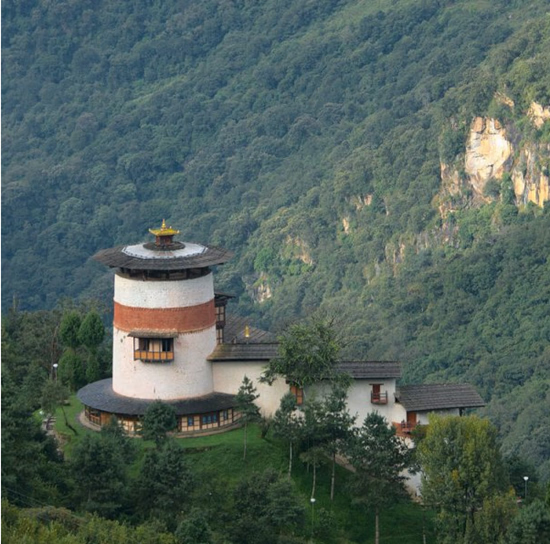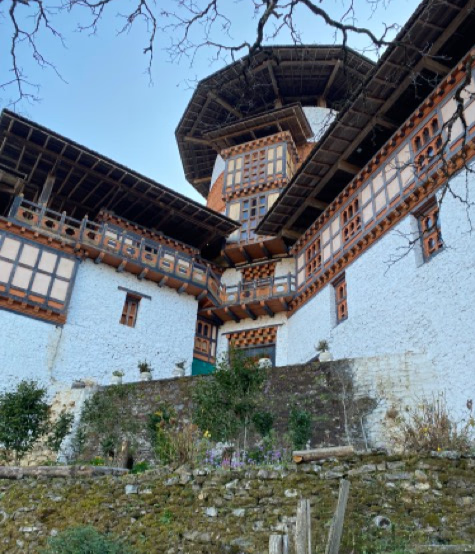Located on a strategic hillside above Trongsa Dzong, Taa Dzong stands as one of Bhutan’s most impressive and historically significant watchtowers. Originally built to safeguard the Trongsa Dzong and the eastern approach to the kingdom, Taa Dzong has since evolved into a captivating museum, offering deep insights into Bhutanese history, royalty, and culture. Its location in Trongsa makes it a must-visit for anyone exploring central Bhutan.

Historical Significance of Taa Dzong
Constructed in 1652 by Choeje Minjur Tenpa, the first Governor of Trongsa, Taa Dzong was designed as a defensive watchtower to protect the strategically vital Trongsa Dzong from internal and external threats. Throughout history, Trongsa has been a seat of power for Bhutanese rulers. The watchtower played a critical role in the consolidation of power by the Wangchuck dynasty, the royal family of Bhutan.
Unique Architecture and Design
Taa Dzong boasts a distinctive cylindrical structure, built on several levels with labyrinthine corridors and secret passageways. Its design reflects traditional Bhutanese fortification techniques, including thick stone walls, narrow windows for archers, and a central tower rising above the surrounding landscape. The architecture is a remarkable example of Bhutanese ingenuity in blending defence with spiritual elements, as evidenced by the presence of chapels and shrines within the tower.
The Tower’s Transformation: From Fortress to Museum
In 2008, Taa Dzong was beautifully restored and inaugurated as the Royal Heritage Museum to commemorate the centenary of Bhutan’s monarchy. This transformation has given visitors unparalleled access to centuries of royal memorabilia, sacred relics, and priceless artefacts. The museum highlights the lives and reigns of Bhutan’s kings, especially the first and second monarchs, whose roots trace back to Trongsa.
Highlights of the Royal Heritage Museum
1. Royal Relics and Memorabilia
The museum showcases an extraordinary collection of royal relics, including the personal belongings, photographs, and ceremonial robes of the Wangchuck dynasty. Visitors can view ancient armour, weaponry, and exquisite textiles that tell the story of Bhutan’s unification.
2. Sacred Artefacts and Buddhist Iconography
Taa Dzong houses a remarkable array of sacred Buddhist artefacts, statues, ritual objects, and thangkas (religious paintings). Many items have been carefully preserved from the 17th century and provide a window into the spiritual life of Bhutanese society.
3. Life and Legacy of Trongsa Penlops
Special exhibits focus on the penlops (governors) of Trongsa, particularly Jigme Namgyel and his son Ugyen Wangchuck, who played pivotal roles in Bhutanese history. The museum traces their influence in shaping the nation and leading Bhutan to the era of monarchy.
4. Panoramic Views and Photography
The upper levels of Taa Dzong offer spectacular panoramic views over Trongsa town, the dramatic river valley, and the imposing Trongsa Dzong below. The vantage point is perfect for photography and for appreciating the strategic importance of the site.

Visitor Experience: What to Expect
A visit to Taa Dzong is both educational and immersive. The exhibits are thoughtfully curated, with English and Dzongkha captions, making the experience accessible for international travellers. Interactive displays and audio guides are often available, further enhancing your understanding of Bhutan’s royal heritage.
The winding climb up to Taa Dzong itself is an experience, as you ascend stone pathways lined with prayer flags and pass traditional Bhutanese homes. The sense of history deepens as you explore each floor, from dungeon-like chambers to shrine-filled halls.
Practical Information for Travellers
Opening Hours: Taa Dzong is usually open to visitors daily, except on public holidays and major religious festivals.
Entry Fees: 500 Nu for tourists
Accessibility: While the climb to the watchtower is moderately steep, it is manageable for most visitors. Inside, some stairways are narrow and steep, so comfortable footwear is recommended.
Getting There: Taa Dzong is a short drive or a scenic uphill walk from central Trongsa town. Guided tours are available through most Bhutan tour operators.
Why Taa Dzong is a Must-Visit in Bhutan
Taa Dzong in Trongsa is a living testament to Bhutan’s resilience, wisdom, and unique identity. By preserving and presenting the treasures of Bhutanese monarchy and Buddhism, it connects visitors to the country’s soul. Whether you are a history enthusiast, a culture lover, or a curious traveller, Taa Dzong offers an enriching journey into the heart of Bhutan.
Frequently Asked Questions
What is the best time to visit Taa Dzong?
Taa Dzong is open to visitors throughout the year, although opening hours may vary during major festivals and public holidays. Travellers are advised to check in advance or consult their tour operator for any seasonal closures or special schedules.
Can I visit Taa Dzong without a guide?
No, you will need to be accompanied by a tour guide to visit the Taa Dzong in Trongsa.
Is photography allowed inside Taa Dzong?
Photography is permitted in most outdoor areas, but certain exhibits may have restrictions to protect sensitive artefacts.
Taa Dzong in Trongsa stands as a guardian of Bhutan’s royal history and cultural treasures. Its majestic architecture, rich museum collections, and breathtaking vistas make it an essential stop for anyone exploring Bhutan. Step inside and journey through centuries of legends, leadership, and legacy—right at the heart of the Kingdom of the Thunder Dragon.